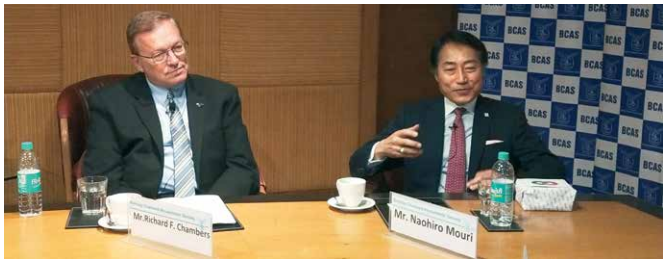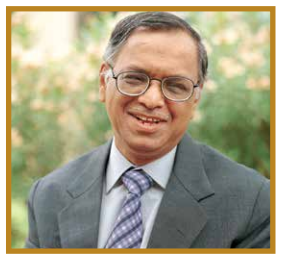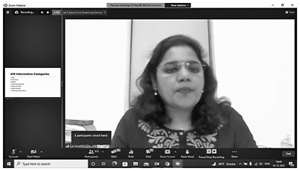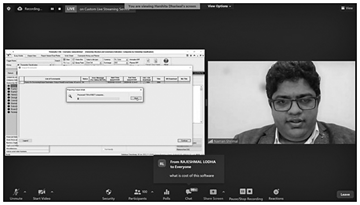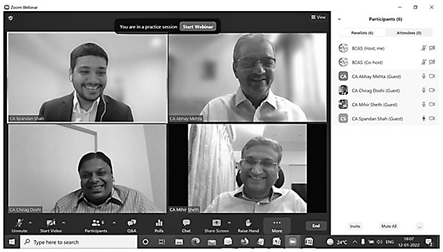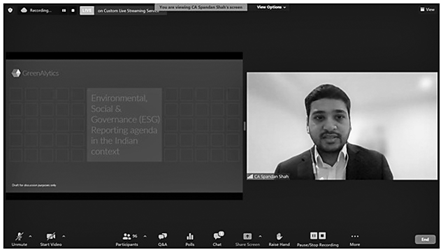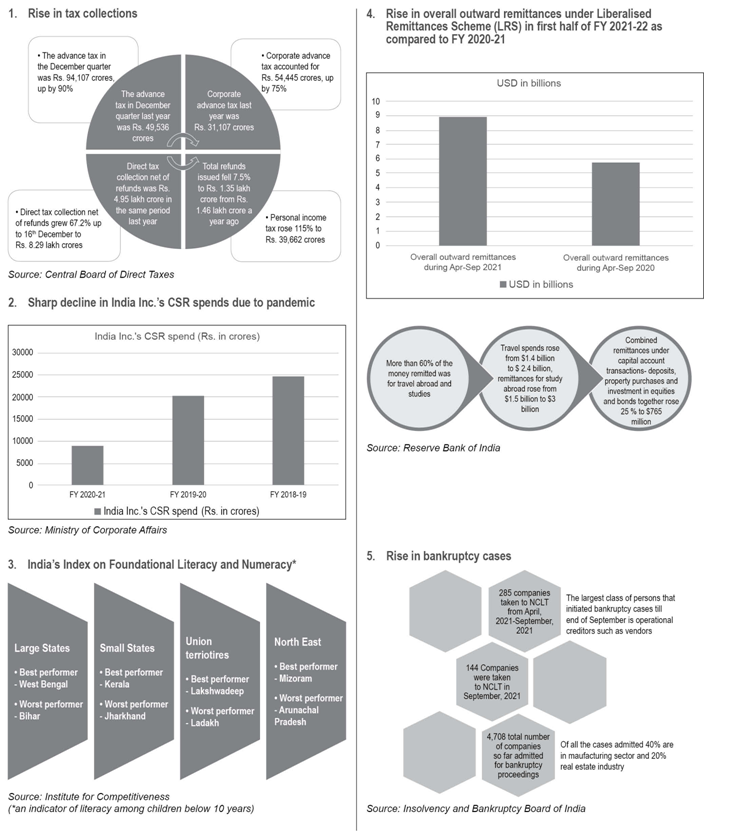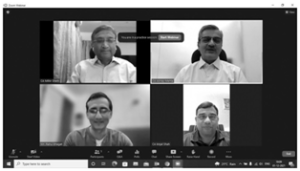In the above case, the amount of Rs. 40 lakhs is regarded to have come out of the F.Y. 2020-21.
Also, see the analysis of Rule 17AA(1)(d)(iii)- ‘Out of previous year’ published on page 25 of October BCAJ.
Application other than the application referred in Item (I) and Item (II), [Item (III)]
Although not explicitly stated, this Item appears to apply to the application to be made within five years u/s11(2).
Money invested or deposited in permissible modes u/s 11(5); [Item (IV)]
The comments in Money invested or deposited in permissible modes of section 11(5) on Page 28 of October BCAJ apply to this para.
Money invested or deposited in impermissible modes [Item (V)]
The comments in Money invested or deposited in non- permissible modes on Page 28 of October BCAJ apply to this para.
Rule 17AA(1)(d)(v)(Text)
Record of voluntary contribution made with a specific direction that they shall form Part of the corpus, in respect of-
(I)
the contribution received during the previous year containing details
of the name of the donor, address, permanent account number (if
available) and Aadhaar number (if available);
(II) application
out of such voluntary contribution referred to in Item (I) containing
details of the amount of application, name and address of the person to
whom any credit or payment is made and the object for which such
application is made;
(III) the amount credited or paid towards
corpus to any fund or institution or trust or any university or other
educational institution or any hospital or other medical institution
referred to in subclause (iv) or sub-clause (v) or sub-clause (vi) or
sub-clause (via) of clause (23C) of section 10 of the Act or other trust
or institution registered under section 12AB of the Act, out of such
voluntary contribution received during the previous year containing
details of their name, address, permanent account number and the object
for which such credit or payment is made;
(IV) the
forms and modes specified in sub-section (5) of section 11 of the Act in
which such voluntary contribution, received during the previous year,
is invested or deposited;
(V) the Money invested or deposited
in the forms and modes other than those specified in subsection (5) of
section 11 of the Act in which such voluntary contribution, received
during the previous year, is invested or deposited;
(VI)
application out of such voluntary contribution, received during any
previous year preceding the previous year, containing details of the
amount of application, name and address of the person to whom any credit
or payment is made and the object for which such application is made;
(VII)
The amount credited or paid towards corpus to any fund or institution
or trust or any university or other educational institution or any
hospital or other medical institution referred to in subclause (iv) or
sub-clause (v) or sub-clause (vi) or sub-clause (via) of clause (23C) of
section 10 of the Act or other trust or institution registered under
section 12AB of the Act, out of such voluntary contribution received
during any year preceding the previous year, containing details of their
name, address, permanent account number and the object for which such
credit or payment is made;
(VIII) the forms and modes
specified in sub-section (5) of section 11 of the Act in which such
voluntary contribution, received during any previous year preceding the
previous year, is invested or deposited;
(IX) The Money
invested or deposited in the forms and modes other than those specified
in subsection (5) of section 11 of the Act in which such voluntary
contribution, received during any previous year preceding the previous
year, is invested or deposited;
(X) The amount invested or
redeposited in such voluntary contribution (which was applied during any
preceding previous year and not claimed as application), including
details of the forms and modes specified in sub-section (5) of section
11 in which such voluntary contribution is invested or deposited;
Analysis
This
sub-clause requires details of receipts of corpus donations and their
utilization. Courts have held that the specific direction can be
inferred in many cases [e.g., when the donation is received to meet the
cost of a building [CIT vs. Sthanakvasi Vardhman Vanik Jain Sangh,
(2003) 260 ITR 366 (Guj); ACIT vs. Chaudhary Raghubir Singh Educational
& Charitable Trust, (2012) 28 taxmann.com 272 (Del)]. This aspect may have to be borne while preparing the details.
Application out of voluntary contribution referred to in Item (I) [Item (II)]
To
avoid any overlap between details under Item (II) and Item (III), the
details under this Item may be restricted to contributions other than
those covered under Item (III), that is, application towards corpus of
specified institutions.
Application out of such voluntary corpus contribution received during any previous year preceding the previous year [Item (VI)]
This item requires maintenance of application details out of corpus received during any previous year preceding the previous year.
Permissible
investments in which such voluntary contribution, received during any
previous year preceding the previous year, is made [Item (VIII)]
This item requires details of permissible investments u/s 11(5) out of corpus received during any previous year preceding the previous year.
The comments in Money invested or deposited in permissible modes of section 11(5) on Page 28 of October BCAJ apply to this para.
Non-permissible
investments made from voluntary corpus contribution received during any
previous year preceding the previous year [Item (IX)]
This item requires details of investments/deposits in impermissible modes out of corpus received during any previous year preceding the previous year.
The comments in the Money invested or deposited in non-permissible modes on Page 28 of October BCAJ apply to this para.
Amount invested or deposited back into corpus [Item (X)]
The
details are required only in respect of such investments or deposits
back into the corpus which satisfies the following conditions:
The voluntary contribution towards corpus was received in any preceding previous year;
Such voluntary contribution was applied during any preceding previous year;
Such application was not claimed as such application during any preceding previous year.
Rule 17AA(1)(d)(viii)[Text]
record
of contribution received for renovation or repair of the temple,
mosque, gurdwara, church or other place notified under clause (b) of
sub-section (2) of section 80G, which is being treated as corpus as
referred in Explanation 1A to the third proviso to clause (23C) of
section 10 or Explanation 3A to sub-section (1) of section 11, in
respect of:
(I) the contribution received during the previous
year containing details of the name of the donor, address, permanent
account number (if available) and Aadhaar number (if available);
(II)
contribution received during any previous year preceding the previous
year, treated as corpus during the previous year, containing details of
name of the donor, address, permanent account number (if available) and
Aadhaar number (if available);
(III) application out of such
voluntary contribution referred to in Item (I) and Item (II) containing
details of the amount of application, name and address of the person to
whom any credit or payment is made and the object for which such
application is made;
(IV) the amount credited or paid towards
corpus to any fund or institution or trust or any university or other
educational institution or any hospital or other medical institution
referred to in sub-clause (iv) or sub-clause (v) or sub-clause (vi) or
sub-clause (via) of clause (23C) of section 10 of the Act or other trust
or institution registered under section 12AB of the Act, out of such
voluntary contribution received during the previous year containing
details of their name, address, permanent account number and the object
for which such credit or payment is made;
(V) the forms and modes specified in sub-section (5) of section 11 of the Act in which such corpus, received during the previous year, is invested or deposited;
(VI)
the Money invested or deposited in the forms and modes other than
those specified in subsection (5) of section 11 of the Act in which such
corpus, received during the previous year, is invested or deposited;
(VII)
application out of such corpus, received during any previous year
preceding the previous year, containing details of the amount of
application, name and address of the person to whom any credit or
payment is made and the object for which such application is made;
(VIII)
the amount credited or paid towards corpus to any fund or institution
or trust or any university or other educational institution or any
hospital or other medical institution referred to in subclause (iv) or
sub-clause (v) or sub-clause (vi) or sub-clause (via) of clause (23C) of
section 10 of the Act or other trust or institution registered under
section 12AB of the Act, out of such voluntary contribution received
during any year preceding the previous year, containing details of their
name, address, permanent account number and the object for which such
credit or payment is made;
(IX) the forms and modes specified
in sub-section (5) of section 11 of the Act in which such corpus,
received during any previous year preceding the previous year, is
invested or deposited; Money invested or deposited in the forms and
modes other than those specified in sub- section (5) of section 11 of
the Act in which such corpus, received during any previous year
preceding the previous year, is invested or deposited;
Analysis
This
sub-clause refers to contributions received by a temple, etc. It
requires details pursuant to Explanation 3A and 3B to section 11(1).
Contribution received during the previous year [Item (I)]
This Item appears to require details of all contributions, whether corpus or otherwise.
Permissible modes in which corpus received during the previous year is invested or deposited [Item (V)]
The details under this Item are partially sought under Item II to rule 17AA(1)(d)(ii).
The comments in Money invested or deposited in permissible modes of section 11(5) on Page 28 of October BCAJ apply to this para.
Non-permissible modes in which corpus received during the previous year is invested or deposited [Item (VI)]
The details under this Item are partially sought under Item II to rule 17AA(1)(d)(ii).
The comments in Money invested or deposited in non- permissible modes on Page 28 of October BCAJ apply to this para.
Rule 17AA(1)(d)(vii)[Text]
record of loans and borrowings,-
(I)
containing information regarding amount and date of loan or borrowing,
amount and date of repayment, name of the person from whom loan taken,
address of lender, permanent account number and Aadhaar number (if
available) of the lender;
(II) application out of such loan or
borrowing containing details of amount of application, name and address
of the person to whom any credit or payment is made and the object for
which such application is made;
(III) application out of such
loan or borrowing, received during any previous year preceding the
previous year, containing details of amount of application, name and
address of the person to whom any credit or payment is made;
(IV)
repayment of such loan or borrowing (which was applied during any
preceding previous year and not claimed as application) during the
previous year;
Analysis
This sub-clause refers to
loans and borrowings by the assessee. Generally, it requires details
pursuant to Explanation 4(ii) to section 11(1).
The sub-clause requires details of loans and borrowings but not advances received.
Information regarding the amount and date of loan or borrowing [Item (I)]
A confirmation from the lender is not required under this Item. However, the assessee should keep it on record.
Application out of such loan or borrowing [Item (II)]
While
the details in respect of any credit or payment out of loans/borrowings
are required under this Item, in view of Explanation to section 11, the
amount credited to a person’s account will not be allowed as an
application of income unless it is paid.
Application out of such loan or borrowing, received during any previous year preceding the previous year [Item (III)]
This Item does not require details of the object for which such an application is made.
Repayment
of such loan or borrowing (which was applied during any preceding
previous year and not claimed as application) during the previous year [Item (IV)]
This Item requires maintenance of details of repayment of loans/borrowings, which satisfy the following conditions:
- The loan/borrowing was effected in the year preceding the previous year;
- Such loan/borrowing is repaid during the previous year;
- The loan/borrowing was applied during any preceding previous year;
- The loan/borrowing was not claimed as an application during any preceding previous year.
To
illustrate, suppose Rs. 1 crore was borrowed in the F.Y. 2021-22 and
Rs. 60 lakhs was applied during the said year but not claimed as
application. In this situation, for F.Y. 2022-23, the rule requires
details of Rs. 60 lakhs and not the other Rs. 40 lakhs not applied
during the previous year.
Rule 17AA(1)(d)(viii)[Text]
record of properties held by the assessee, with respect to the following, namely, –
(I) immovable properties containing details of,
(i) nature, address of the properties, cost of acquisition of the asset, registration documents of the asset;
(ii) transfer of such properties, the net consideration utilized in acquiring the new capital asset;
(II) movable properties, including details of the nature and cost of acquisition of the asset;
Analysis
This
clause requires details of all properties of the assessee. Some details
are also required by Item II in Rule 17AA(1)(d)(ii). (Also refer Part I
of this article)
Immovable Properties [item (I)]
The term “immovable property” is defined in the explanation to section 11(5) as follows:
“Immovable
property” does not include any machinery or plant (other than machinery
or plant installed in a building for the convenient occupation of the
building) even though attached to, or permanently fastened to, anything
attached to the earth;
The definition is negative, hence some
elements of the following definition of “immovable property” in section
3(26) of the General Clauses Act, 1897 may become applicable:
“immovable
property” shall include land, benefits to arise out of the land, and
things attached to the earth, or permanently fastened to anything
attached to the earth;
The Item does not differentiate
between properties acquired as investment and properties acquired for
the purpose of activity of the assessee. Thus, land and building on
which a school is situated is required to be recorded.
Courts have held that tenancy
rights are immovable property of the tenant. [Jagannath Govind Shetty
vs. Javantilal Purshottamdas Patel, AIR 1980 Guj 41; Lal & Co. And
Anr. Vs. A.R. Chadha And Ors., ILR 1970 Delhi 202; Kanhaiya Lal v. Satya
Narain Pandey, AIR 1965 All 496]. Thus, tenancy rights are also immovable properties whose details are required to be recorded.
The
rule does not require details of sale consideration, expenditure in
relation to transfer, etc. However, it is advisable that such details
are also recorded.
Movable Properties [item (II)]
The term “moveable properties” is defined in section 2(36) of the General Clauses Act, 1897 as “property of every description, except immovable property.”
Thus,
all properties including plant and machinery, furniture and fixtures,
investments, cash and bank balance, book debt, loans and advances, and
inventory are also movable properties!
The rule does not
distinguish between movable property as investment or as capital asset
or otherwise in connection with the activities. Hence, for an assessee
running an institution such as a hospital, every piece of equipment,
furniture etc. is a movable property and its details are required!!
Details of all assets, whether existing on 31st March or not, are required to be recorded!!
Rule 17AA(1)(d)(ix)[Text]
record of specified persons, as referred to in sub-section
(3) of section 13 of the Act,-
(I) containing details of their name, address, permanent account number and Aadhaar number (if available);
(II)
transactions undertaken by the fund or institution or trust or any
university or other educational institution or any hospital or other
medical institution with specified persons as referred to in sub-section
(3) of section 13 of the Act containing details of date and amount of
such transaction, nature of the transaction and documents to the effect
that such transaction is, directly or indirectly, not for the benefit of
such specified person;
Analysis
This clause requires
details of “interested parties” u/s 13(3) and the transactions with
them. Its details are required pursuant to section 12(2), 13(1)(c),
13(2) and 13(4) of the Act.
Interested parties [Item (I)]
The record will have to be updated, if the interested parties change during the year, e.g.
- person makes a voluntary contribution of more than Rs. 50,000 during the year and becomes an interested party u/s 13(3)(b).
- there is a change in the trustees.
A
substantial contributor is an interested party and includes any person
who has contributed Rs. 50,000 or above in aggregate to an assessee. To
illustrate, if a person has donated Rs. 5,000 per year from 1980 to
1990, he became a ‘substantial contributor’ from financial year 1990-91
onwards and his details are required to be maintained!!
Transactions [Item (II)]
Section
13(2) generally requires comparison with arm’s length price to
determine whether the benefit is granted to an interested party or not.
However, this sub-clause does not specifically require co-relation with
arm’s length price.
The assessee will need to give reference to
documents showing that no benefit is given to the interested party. For
this purpose, different transactions will require other documents. To
illustrate:
- in case of remuneration to an interested party,
evidence regarding his educational qualifications or experience in the
relevant field or amount paid by the assessee to a non-interested person
for similar work, etc., may be required.
- In case of a sale
transaction, a document showing the price at which it has been sold to
other parties or the evidence regarding the market price of the product,
etc., may be required.
Rule 17AA(1)(d)(x)[Text]
Any other documents containing any other relevant information. [Rule 17AA(1)(d)(x)]
Analysis
This
is a very subjective requirement: it means that the assessee has to
determine whether any other document contains any “relevant information”
and, if so, maintain it. Now, the maintenance of documents is
mandatory. Hence, if the AO believes that any other document not
maintained by the assessee has “relevant information”, then he can hold that the assessee has not maintained the prescribed documents !! This is too wide a discretion given to AOs.
Rule 17AA(2)[Text]
The
books of accounts and other documents specified in sub-rule (1) may be
kept in written form, electronic form, digital form, or as printouts of
data stored in electronic form, digital form, or any other form of
electromagnetic data storage device.
Analysis
This
requirement reproduces the definition of “books of accounts” in section
2(12A). Under this provision, documents must also be maintained in
written or electronic form.
It appears that a combination of print and handwritten books of account/document is also permitted.
Rule 17AA(3)[Text]
The
books of account and other documents specified in sub-rule (1) shall be
kept and maintained by the fund or institution or trust or any
university or other educational institution or any hospital or other
medical institution at its registered office:
Provided
that all or any of the books of account and other documents as referred
to in sub-rule (1) may be kept at such other place in India as the
management may decide by way of a resolution and where such a resolution
is passed, the fund or institution or trust or any university or other
educational institution or any hospital or other medical institution
shall, within seven days thereof, intimate the jurisdictional Assessing
Officer in writing giving the full address of that other place and such
intimation shall be duly signed and verified by the person who is
authorized to verify the return of income u/s 140 of the Act, as
applicable to the assessee.
Analysis
The books of
accounts and documents have to be maintained at the registered office.
Under the Companies Act 2013 (“CA 2013”), the books of account and other
records have to be kept at the registered office [s.128(1)]. Under the
Central Goods and Services Tax Act, 2017 (“the CGST Act”), the accounts
and records have to be kept at the principal office mentioned in the
certificate of
registration. [s.35(1)].
A company incorporated
under CA 2013 must have a registered office [s.12(1)]. In case of a
trust or a society registered under Societies Registration Act, 1860
there is no such statutory requirement. Since the Rules and the Act do
not define a registered office, such entities can designate any office
as a registered office. However, it should be the same as the office
specified in Form 10A/10B (application for registration) and in ITR-7.
Place where the books of accounts on electronic platform are maintained
The
Guidance Note on Tax Audit u/s 44AB of the Act, A.Y.2022-23 issued by
the Institute of Chartered Accountants of India, states as follows:
In
case, where books of account are maintained and generated through the
computer system, the auditor should obtain from the assessee the details
of the address of the place where the server is located or the
principal place of the business/head office or registered office by
whatever name called and mention the same accordingly in clause 11(b).
Where the books of account are stored on the cloud or online, IP address
(unique) of the same may be reported. (page 72).
Exception
The
books of accounts and documents may be maintained at a place other than
the registered office if the following conditions are satisfied:
- The other place is in India;
- The management decides by way of a resolution as to where the books/documents will be kept;
- An intimation is sent in writing to the jurisdictional AO giving the full address of that other place;
- the intimation is duly signed and verified by the person authorized to verify the return of income u/s 140;
- the assessee intimates the AO within 7 days of the resolution.
A similar provision is found in section 128 of the CA 2013.
The
books of accounts may be kept at some other “place” which should be
construed to mean places, applying the principle in section 13 of the
General Clauses Act, 1897 that singular includes plural.
The
proviso provides that “any or all” the books of account may be kept at
other places. Hence, the books/documents may be kept partially at one
place and partially at some other place or places.
Intimate
The assessee shall “intimate” the AO. Dictionaries explain the term as follows:
(i) To make known; formally to notify
[Legal Glossary 2015 by Govt of India, page 225]
(ii) to make known especially publicly or formally:
[https://www.merriam-webster.com]
Thus,
“intimate” means “make known”; in other words, the AO should know that
the resolution has been passed, and such knowledge should be conveyed to
him within seven days of the passing of the resolution. The assessee
may not be able to argue that it has posted the intimation within seven
days of passing of the resolution and hence there is no default, even if
the intimation has not reached the AO.
No particular format is provided for the intimation.
A
similar requirement to keep books of account/other documents at the
registered office is not found in the Act for other profit
organizations.
Suppose the books/documents are temporarily
shifted elsewhere, say, for audit or for compilation of details to be
furnished to the AO, or to be presented to the GST authorities, etc. It
appears that such temporary movement does not mean that the books of
accounts/documents have not been kept and maintained at the registered
office or the designated place.
Rule 17AA(4)[Text]
“The
books of account and other documents specified in sub-rule (1) shall be
kept and maintained for a period of ten years from the end of the
relevant assessment year:
Provided that where the assessment in
relation to any assessment year has been reopened under section 147 of
the Act within the period specified in section 149 of the Act, the books
of account and other documents which were kept and maintained at the
time of reopening of the assessment shall continue to be so kept and
maintained till the assessment so reopened has become final.”
Analysis
The
books of account/documents must be kept for 10 years from the end of
the relevant assessment year (11 years from the end of the relevant
financial year). The corresponding requirement under the CA 2013 and
CGST Act 2017 is 8 financial years1 and 72 months2 from the due date of furnishing the annual return pertaining to the account records.
The period of 10 years corresponds with the maximum reassessment period u/s 149.
The
expression “final” would, perhaps, mean when neither the assessee or
the tax department challenges the reassessment any further and the AO
has passed the final order giving effect to the order by the Appellate
Authority.
The books of accounts/documents kept and maintained at
the time of reopening of the assessment shall continue to be kept and
maintained. On a literal interpretation, all books of accounts/documents
have to be kept and maintained whether or not they have bearing on the
matter under reassessment.
The proviso does not have
retrospective applicability; hence, it should apply only to books of
accounts/ documents prepared after the Rule has come into force. To
illustrate, suppose the assessment for F.Y. 2021-22 is reopened in F.Y.
2025-26 and is not final as on 31st March, 2032. In this case, the
proviso does not apply since the Rule itself is not applicable and
hence, the books of accounts/document need not be kept and maintained
till the reassessment is final. On the other hand, the books for the
year 2022-23 are required to be maintained up to end of 2032-33. Suppose
the assessment for the A.Y. 2023-24 is reopened in F.Y. 2027-28, and it
is not final till 31st March, 2033. Then the books of
accounts/documents for the said year must be maintained till the
reassessment becomes final.
1 Section 128(5)
2 Section 36

